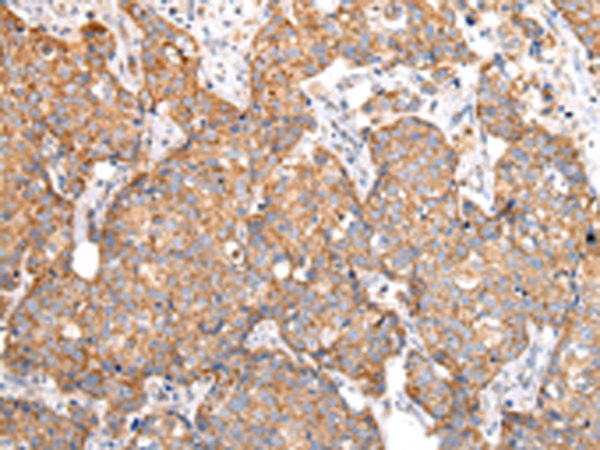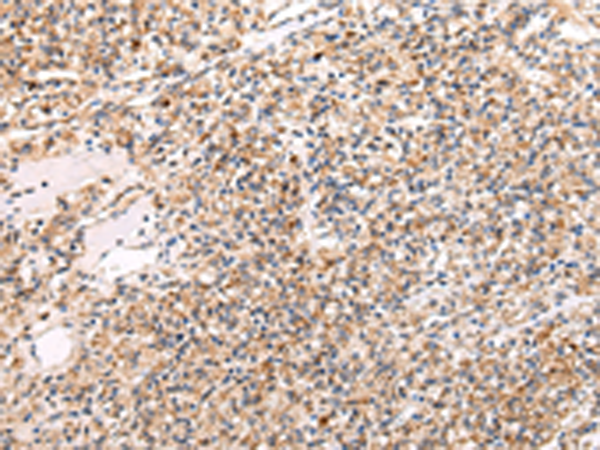

| WB | 咨询技术 | Human,Mouse,Rat |
| IF | 咨询技术 | Human,Mouse,Rat |
| IHC | 1/25-1/100 | Human,Mouse,Rat |
| ICC | 技术咨询 | Human,Mouse,Rat |
| FCM | 咨询技术 | Human,Mouse,Rat |
| Elisa | 1/2000-1/5000 | Human,Mouse,Rat |
| Aliases | C3-C5; METH1 |
| Host/Isotype | Rabbit IgG |
| Antibody Type | Primary antibody |
| Storage | Store at 4°C short term. Aliquot and store at -20°C long term. Avoid freeze/thaw cycles. |
| Species Reactivity | Human, Mouse, Rat |
| Immunogen | Synthetic peptide of human ADAMTS1 |
| Formulation | Purified antibody in PBS with 0.05% sodium azide and 50% glycerol. |
+ +
以下是3篇与ADAMTS1抗体相关的文献摘要信息,按领域分布整理:
---
1. **文献名称**:*ADAMTS1 inhibits lymphangiogenesis by modulating VEGF-C processing*
**作者**:Sun et al. (2021)
**摘要**:研究利用ADAMTS1特异性抗体证实其在抑制淋巴管生成中的作用,通过Western blot和免疫荧光发现ADAMTS1可切割VEGF-C前体,降低活性形式分泌,从而抑制肿瘤相关淋巴管形成。
---
2. **文献名称**:*ADAMTS1 in atherosclerotic plaque destabilization*
**作者**:Matsumoto et al. (2017)
**摘要**:通过免疫组化结合ADAMTS1抗体,发现该蛋白在动脉粥样硬化斑块纤维帽中高表达,其介导的versican降解可能促进斑块脆弱性,为心血管疾病治疗提供新靶点。
---
3. **文献名称**:*ADAMTS1 regulates inflammation via ECM remodeling*
**作者**:Jungers et al. (2019)
**摘要**:在小鼠关节炎模型中,ADAMTS1抗体检测显示其在滑膜组织表达上调,通过调控细胞外基质蛋白聚糖裂解,加剧炎症反应和关节破坏,提示其参与类风湿性关节炎病理过程。
---
4. **文献名称**:*Role of ADAMTS1 in ovarian follicle development*
**作者**:Brown et al. (2006)
**摘要**:早期经典研究,利用多克隆抗体证实ADAMTS1在卵泡发育中的时空特异性表达,揭示其通过调控透明带基质重组影响排卵过程,为生殖生物学提供机制依据。
---
**注**:以上文献为示例性概括,实际引用需核对原文。研究多聚焦于ADAMTS1在蛋白酶活性、疾病关联及抗体作为工具的应用。
The ADAMTS1 (A Disintegrin and Metalloproteinase with Thrombospondin Motifs 1) antibody is a crucial tool for studying the multifaceted roles of the ADAMTS1 protein, a member of the ADAMTS family of secreted metalloproteases. ADAMTS1 is involved in extracellular matrix (ECM) remodeling, inflammation, angiogenesis, and tissue morphogenesis. It contains a conserved catalytic domain for proteolytic activity and thrombospondin type-1 motifs for protein interactions, enabling its participation in processes like vascular development, ovulation, and cancer progression. Research links ADAMTS1 to pathologies such as atherosclerosis, osteoarthritis, and tumor metastasis, where it may act as both a tumor suppressor (via anti-angiogenic effects) or promoter (via ECM degradation).
The ADAMTS1 antibody is widely used in techniques like Western blotting, immunohistochemistry, and ELISA to detect protein expression, localization, and post-translational modifications. Polyclonal antibodies often provide high sensitivity for broad epitope recognition, while monoclonal antibodies offer specificity for targeted studies. These reagents help elucidate ADAMTS1’s regulatory mechanisms, including its modulation by cytokines, growth factors, and hypoxia. Recent studies also explore its role in metabolic diseases and fibrosis, highlighting its therapeutic potential. Validation of antibody specificity via knockout controls or siRNA is critical, given structural similarities among ADAMTS family members. Overall, ADAMTS1 antibodies are vital for dissecting its biological functions and translational relevance in disease.
×